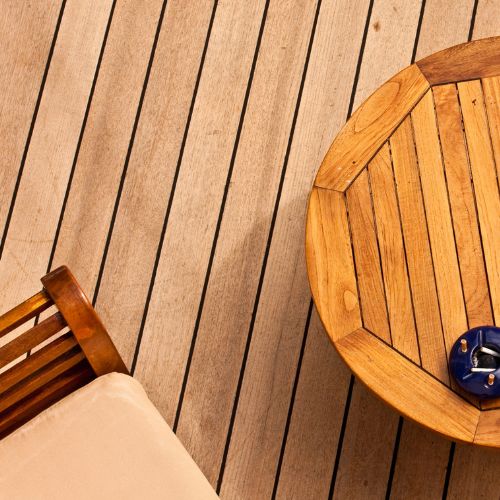How to Repair a Damaged Outdoor Ottoman? | Posh Living Magazine

Key Takeaways -
- Repairing an outdoor ottoman can save money and extend its lifespan.
- Disassembling, reinforcing the frame, and reupholstering are key repair steps.
- Using the right tools and materials makes the repair process easier.
- Regular maintenance and protective measures help prevent future damage.
A damaged outdoor ottoman doesn’t need to be thrown away. With some simple repairs, you can bring it back to life and keep using it for years. Whether it’s torn fabric, a sagging cushion, or a loose frame, fixing your ottoman yourself is a great way to save money.
This guide will show you how to assess the damage, gather the tools you need, and repair your ottoman step by step. You’ll learn how to strengthen the frame, replace the fabric, and refresh the cushion to make it look and feel new again.
Keep reading to find out how to repair your ottoman easily. With a little effort, you can restore it and enjoy a refreshed piece of furniture in no time.

Assessing the Damage
Types of Common Damage
Start by checking the fabric for any tears, holes, or worn spots. These can happen from regular use or exposure to the elements. Next, inspect the frame for any cracks, loose joints, or areas that feel unsteady, as a weak frame can cause sagging or instability.
Also, examine the legs or feet to see if any are damaged, loose, or uneven, which can affect the balance of the ottoman. Finally, press down on the cushion to check if it feels flat or has lost its shape, indicating worn-out foam or padding.
Tools and Materials Needed for Assessment
To get started, you’ll need a tape measure for checking fabric dimensions and frame parts. Pliers will come in handy for removing staples, nails, or other fasteners. Have some fabric swatches or samples on hand to help match new fabric if needed.
You may also need replacement wood or hardware to fix any frame or leg issues. Choose a new fabric that is outdoor-grade for durability, and keep some plywood ready for reinforcing or replacing parts of the frame.
Preparing for Repair
Gathering Essential Tools and Materials

Before starting the repair, make sure you have all the necessary tools and materials ready. These will help you complete each step smoothly and efficiently:
- Staple gun and staples for securing fabric
- Fabric adhesive for smaller fixes
- Sewing kit (thread, needle, etc.) for fabric repairs
- Replacement fabric or foam to refresh worn areas
- Screws, nails, and wood glue for structural work
- Scissors for cutting fabric
- Screwdriver for hardware adjustments
- Sewing machine (optional) for faster and more precise fabric work
Setting Up a Work Area
Choose a workspace that suits your project, whether indoors or outdoors. An indoor area is ideal for avoiding dust and debris, while an outdoor space can offer more room.
Wherever you set up, cover the work surfaces with a cloth or tarp to protect them from damage and keep tools organised. This helps create a clean, safe environment for the repair process.
Step-by-Step Guide to Repairing an Outdoor Ottoman
Step 1: Disassemble the Ottoman

Flip the ottoman over to access the underside, then use pliers or a screwdriver to remove any staples or screws holding the fabric. Carefully take off the old fabric to expose the frame. Once disassembled, inspect the frame and cushion for any structural damage or wear.
Look closely for signs of dry rot in the foam or batting, as these will need to be replaced during the repair.
Step 2: Repair the Frame
To reinforce weak or broken parts, cut two pieces of plywood to fit the top and bottom of the frame. Secure them with screws to provide a sturdy base and prevent future sagging.
Check the legs for stability and balance; reattach any loose legs with screws or brackets, and replace any that are damaged to ensure the ottoman is steady.
Step 3: Reupholster the Fabric
Carefully remove the existing fabric and staples, keeping the original batting if it's still usable. Measure the ottoman to ensure a snug fit for the new fabric, then cut it to size. Optionally, sew the fabric into a slipcover. Starting on one side, pull the fabric tight and staple it to the underside.
Smoothly wrap the fabric across the top, add batting if needed, and secure everything with neat folds at the corners.
Step 4: Repair or Replace the Cushion
Examine the foam for sagging or wear and decide if it needs to be replaced or refilled. Choose foam that provides comfort and durability, then cut it to fit the ottoman precisely. Attach the foam securely to the frame.
For extra comfort, consider adding memory foam or additional batting, securing the layers with fabric adhesive for a snug and even fit.
Step 5: Add Finishing Touches
Reinstall the ottoman legs and any other removed components, tightening all screws for stability. Apply a waterproofing spray to protect the fabric from moisture, and use wood finish or varnish on any wooden parts.
Finally, inspect your work for loose staples, uneven fabric, or other imperfections, making final adjustments to achieve a polished and high-quality finish.
Frequently Asked Questions
Can I Repair an Outdoor Ottoman Without Any Sewing Skills?
Yes, you can repair an outdoor ottoman without needing sewing skills. Many tasks, such as reinforcing the frame, reattaching loose fabric with a staple gun, or replacing the cushion foam, can be done easily without sewing (1).
However, if you want to create a slipcover or perform detailed fabric work, basic sewing might be helpful. Most repairs can be accomplished with simple tools and techniques.
How Do I Fix a Wobbly Ottoman?
To fix a wobbly ottoman, start by checking if any screws or bolts in the legs are loose and tighten them as needed. If the legs are uneven, you may need to add rubber pads or shims to stabilise them.
For structural issues, applying wood glue to reinforce joints can help improve stability. Regular maintenance can prevent future wobbling and ensure long-lasting support.
Conclusion

In conclusion, repairing a damaged outdoor ottoman is a straightforward DIY project that can save you money and extend the life of your furniture.
By following the step-by-step guide to disassemble, repair the frame, reupholster, and refresh the cushion, you can restore the ottoman to its original comfort and appearance.
With the right tools and a little effort, your ottoman can look and feel as good as new, ready for continued use in your outdoor space. Regular maintenance and protection will also help keep it in top shape for a long time.
Sources -
- https://www.suburble.com/2013/07/the-no-sew-way-to-recover-an-ottoman.html












